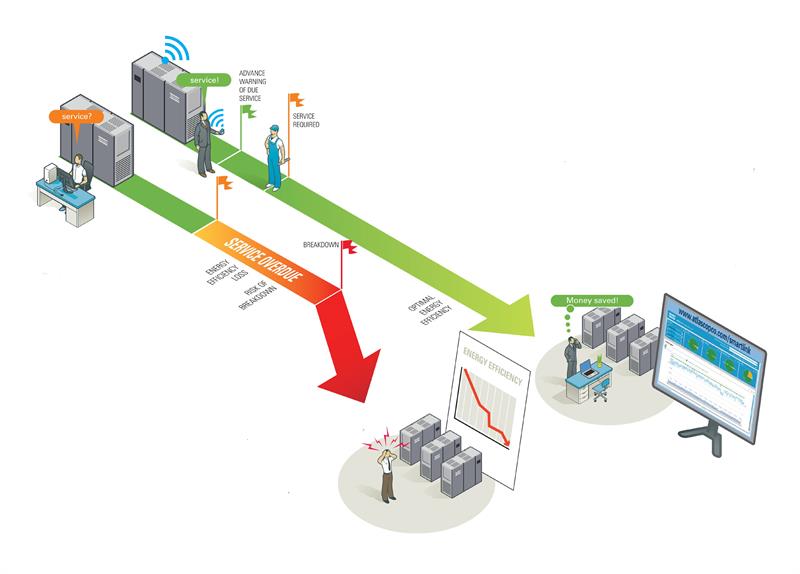As one of the world’s major industrial energy sources, which is estimated to account for 10% of all energy used in industry globally, compressed air will undoubtedly have a significant role to play in shaping the smart factories of the future. But, you may ask, what is being done now within the compressed air industry to embrace Industry 4.0?
The concept of adding intelligence to air compressors by connecting and enabling them to communicate over the internet is not new. In fact, as of today, Atlas Copco has over 100,000 connected compressors operating at more than 35,000 customer sites in the world. These compressors are delivering more than 150 data measurements per second. This is proving vital on one hand in enabling data mining engineers to intelligently analyse performance patterns and on the other, by helping design teams to apply the data in the development of new and more customer-suited compressed air technologies.
For some time now, smart controller technology has enabled plant managers to keep track of how their compressor is performing via MODBUS or PROFIBUS internet connections to a central plant management system. These types of control system are effectively the ‘brain’ of a compressor: collecting data via built-in sensors, processing it and then providing plant managers with an overview of how their compressed air system is performing.
More recent advances have enabled compressor controllers to be connected to mobile devices through systems such as SMARTLINK, which facilitates remote monitoring over a secure network. This means that operators can keep track of key parameters including pressure, flow, motor and dryer speeds and then make adjustments when necessary via a compressor’s manual interface. This enables varying production demands to be accommodated and can help plant managers improve efficiency and save energy.
The next conceivable step is to take this final, manual stage out of the hands of compressor operators by enabling air compressors themselves to track and make process improvements autonomously as independent cyber physical systems. Research is being undertaken to develop this technology. However, for the time being remote condition monitoring is the most tangible example of a fledgling IoT technology that is already having an impact in the compressed air industry.
Indeed, there have been such major leaps forward in this area that it has led to the creation of a sub-set of the Industry 4.0 movement known as Preventative Maintenance 4.0. In the realm of compressed air technology, the major development here has been the introduction of technology that combines hardware with customisable data monitoring software.
 This enables maintenance and service engineers to remotely track indicators such as specific energy and compressed air pressure calculations so that immediate improvements can be made when needed. During this process, data is gathered, compared, and analysed. When required, warnings can be sent out in order to prevent downtime and to allow local service providers to plan and prepare their interventions.
This enables maintenance and service engineers to remotely track indicators such as specific energy and compressed air pressure calculations so that immediate improvements can be made when needed. During this process, data is gathered, compared, and analysed. When required, warnings can be sent out in order to prevent downtime and to allow local service providers to plan and prepare their interventions.
Knowing the status of compressed air equipment at all times is the surest way for plant managers and maintenance professionals to spot any developing problems, uncover potential energy savings and achieve maximum uptime of both compressors and the production lines they support. These insights can be realised through a remote data monitoring system, which is illustrated by a number of recent use cases.
For instance, when a period of cold weather caused a cereal manufacturer’s compressors to run at a particularly low ambient temperature, a remote data monitoring programme picked up warnings from the units’ electronic condensate drains and triggered a visit to the site by a service engineer. This early intervention saw the customer fit temporary heaters to prevent the drains freezing up, which could have led to compressor element damage, condensate reaching the air network, and substantial breakdown costs.
In another use case a remote data monitoring system picked up an instance where the element temperatures were inefficiently high in all of the compressors at a steel manufacturer’s site. On inspection, a service engineer found that the compressor room was poorly ventilated, leading to a temperature of +400°C in the room.A complete redesign of the compressor room was recommended. In the meantime, service engineers made sure the compressor coolers were kept clean and the oil was topped up to prevent overheating.
What this all illustrates is that the application of connectivity and remote condition monitoring technology within compressed air equipment is neither new nor incompatible, with great scope for further adoption and opportunities for the IoT to enhance best practice in compressed air operations. This could ultimately lead to a situation where compressed air systems operate independently as cyber physical systems in their own right, making autonomous adjustments to pressure and flow to facilitate process improvements.
This will not eliminate the role of the compressor operator, however. Humans will still hold a vital position as the interface between compressors and the wider smart factory environment, which is shown by the benefit that remote data monitoring equipment is having now in facilitating preventative maintenance and improving uptime.
About the author:
Stef Lievens is business line manager at Atlas Copco Compressors UK





